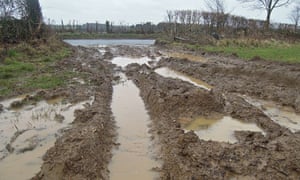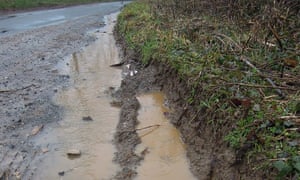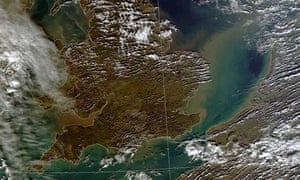That’s what I saw on Tuesday. On Friday, I travelled to the source of the Thames. Within 300 metres of the stone that marked it were ploughed fields, overhanging the catchment, left bare through the winter and compacted by heavy machinery. Muddy water sluiced down the roads. A few score miles downstream it will reappear in people’s living rooms. You can see the same thing happening across the Thames watershed: 184 miles of idiocy, perfectly calibrated to cause disaster.
Two realities, perennially denied or ignored by members of this government, now seep under their doors. In September the environment secretary, Owen Paterson, assured us that climate change “is something we can adapt to over time and we are very good as a race at adapting“. If two months of severe weather almost sends the country into meltdown, who knows what four degrees of global warming will do?
The second issue, once it trickles into national consciousness, is just as politically potent: the government’s bonfire of regulations.

Almost as soon as it took office, this government appointed a task force to investigate farming rules. Its chairman was the former director general of the National Farmers’ Union. Who could have guessed that he would recommend “an entirely new approach to and culture of regulation … Government must trust industry”? The task force’s demands, embraced by Paterson, now look as stupid as Gordon Brown’s speech to an audience of bankers in 2004: “In budget after budget I want us to do even more to encourage the risk takers.”
Farmers have been ploughing land that was previously untilled and switching from spring to winter sowing, leaving the soil bare during the rainy season. Worst of all is the shift towards growing maize, whose cultivated area in this country has risen from 1,400 hectares to 160,000 since 1970.
In three quarters of the maize fields in the south-west, the soil structure has broken down to the extent that they now contribute to flooding. In many of these fields, soil, fertilisers and pesticides are sloshing away with the water. And nothing of substance, the paper warned, is being done to stop it. Dated: December 2013.
Maize is being grown in Britain not to feed people, but to feed livestock and, increasingly, the biofuel business. This false solution to climate change will make the impacts of climate change much worse, by reducing the land’s capacity to hold water.
The previous government also saw it coming. In 2005 it published a devastating catalogue of the impacts of these changes in land use. As well as the loss of fertility from the land and the poisoning of watercourses, it warned, “increased run-off and sediment deposition can also increase flood hazard in rivers”. Maize, it warned, is a particular problem because the soil stays bare before and after the crop is harvested, without the stubble or weeds required to bind it. “Wherever possible,” it urged, “avoid growing forage maize on high and very high erosion risk areas.”
The Labour government turned this advice into conditions attached to farm subsidies. Ground cover crops should be sown under the maize and the land should be ploughed, then resown with winter cover plants within 10 days of harvesting, to prevent water from sheeting off. So why isn’t this happening in Somerset?
Because the current government dropped the conditions. Sorry, not just dropped them. It issued – wait for it – a specific exemption for maize cultivation from all soil conservation measures.

When soil enters a river we call it silt. A few hundred metres from where the soil is running down the hills, a banner over the River Parrett shouts: “Stop the flooding, dredge the rivers.” Angry locals assail ministers and officials with this demand. While in almost all circumstances, dredging causes more problems than it solves, and though, as even Owen Paterson admits, “increased dredging of rivers on the Somerset Levels would not have prevented the recent widespread flooding”, there’s an argument here for a small amount of dredging at strategic points.
But to do it while the soil is washing off the fields is like trying to empty the bath while the taps are running.

So why did government policy change? I’ve tried asking the environment department: they’re as much use as a paper sandbag. But I’ve found a clue. The farm regulation task force demanded a specific change: all soil protection rules attached to farm subsidies should become voluntary. They should be downgraded from a legal condition to an “advisory feature”. Even if farmers do nothing to protect their soil, they should still be eligible for public money.
You might have entertained the naive belief that in handing out billions to wealthy landowners we would get something in return. Something other than endless whining from the National Farmers’ Union. But so successfully has policy been captured in this country that Defra – which used to stand for the Department for Environment, Food and Rural Affairs – now means Doing Everything Farmers’ Representatives Ask. We pay £3.6bn a year for the privilege of having our wildlife exterminated, our hills grazed bare, our rivers polluted and our sitting rooms flooded.
Yes, it’s a parable all right, a parable of human folly, of the kind that used to end with 300 cubits of gopher wood and a journey to the mountains of Ararat. Antediluvian? You bet it is.
Twitter: @georgemonbiot. A fully referenced version of this article can be found at Monbiot.com

Leave a Reply